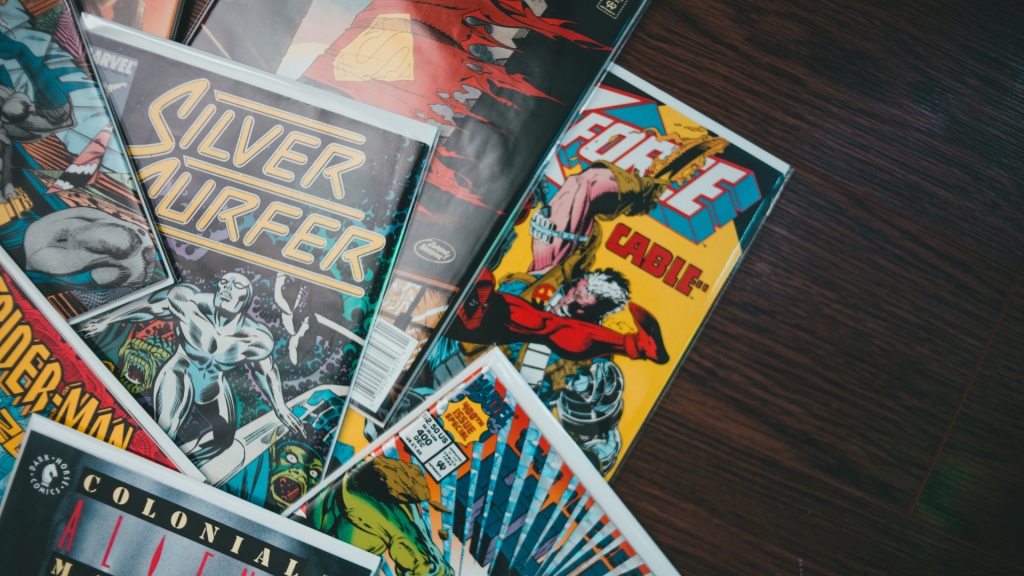If you want to write a screenplay, then you more than likely will be able to find some help out there to do so, but if you would like to write a comic book script then you may find that this kind of information is thin.
If you independently create your own comics and would like to continue that with your own comic book script, then you have a lot more freedom with what your format is and how you want to publish it.
Being a comic book writer can be thrilling as you are able to build on different characters and universes to develop right before your eyes. However, if this is your first time writing a comic script, then you may need some help in getting started.

We All Start Somewhere
Everyone needs to start somewhere, so before you are an expert at writing comics and creating worlds, you need to build on the knowledge you have so that when your finished comic book script is made public, you are happy with the outcome.
It Takes Time and Dedication
The writing process with comic book scripts can be hard for some, even if they have started this all themselves. Connecting these visuals with well-thought-out and informative dialogue might be a weak spot, but with the right help, comic book writers (like yourself) can excel at making comics come together.

What is a Comic Book?
Comic books are for all ages, despite the fact that people would see them as mainly for children or young people, comic books can be adored by people across the board, just look at how popular they have become over the years with film adaptations.
They are visual forms of storytelling with text accompanying the panels. These panels are self-contained boxes that follow the storyline, e.g. dialogue, establishing shots, expressions, and moments, each panel means something to the structure.

Freedom of Expression
Comic books can be a freeing creation for comic book writers and comic creators in general, they are able to experiment and decide on the course of their comic book.
Whether they want to go full Marvel style or get their inspiration from DC comics/Manga comics. It’s up to them.
What Type of Comic Script Format Should be Used?
It is recommended that a traditional three-act structure should be used for a full script comic as this will help with setting the pace.
No matter if it is a stand-alone comic or a series of graphic novels, this type of structure is traditionally recommended, but this is up to you.

What Makes a Good Comic Book?
To make a comic book work and draw people in, there are quite a few elements to consider. From science fiction to superheroes, a comic book needs to incorporate these together so that readers move from one comic book page to the next and remain enthralled.
- Panel – they will move the story along and keep to the story structure
- Gutter – the space between the panels
- Tier – a single row of panels
- Splash – this is a full-page illustration that will help establish the story as well as the mood of it
- Spread – an illustration that will go from one page to the next
- Caption – this has text that can provide context to the pages, normally provided by the narrator
- Speech Bubble – dialogue of the characters. It should have a tail leading to whoever is talking
Keep in mind that a comic book is not solely defined by its well-written comic strips and interior illustrations; it also boasts captivating covers. Much like with traditional novels, the cover of a comic book serves as its face, offering a tantalizing preview of the adventures and characters contained within. A striking comic book cover not only entices potential readers but also sets the tone for the entire story.
From bold, action-packed designs to whimsical and imaginative illustrations, comic book covers come in a wide range of styles, reflecting the diverse genres and themes found within the pages. Artists and writers often collaborate closely to ensure that the cover captures the essence of the story while also standing out amidst the competition on comic book store shelves or online platforms.
Additionally, writers can now leverage free e-book design choices and paperback design options to create captivating covers for their comic books. These tools can empower authors to unleash their creativity and create covers that not only grab attention but also enhance the overall reading experience for audiences worldwide.

How to Start Your Script Writing Process For Your Comic Book
Before you start writing your script pages, you need to set out how you are going to approach this process so that when you see the comic published you will be delighted with the script’s format and the pacing of your work.
Decide on What Type of Script You Want to Write
If you think a plot-first script (also known as a Marvel-style script) is the right choice for you, then you will need to plan to write around this format.
The script writer will give artistic license to the comic creator by leaving out certain instructions so they can build on their own ideas, however, if this is you, then you already know the background.

What Does a Plot First Script Entail?
This type of script will include the narrative arc, characters, and page instructions. The number and arrangement of the panels are left up to the comic book artist. So, you may come to the panels and then write in the dialogue or narrative so it fits in.
This may not be great for some writers who would like the art to match the words, but being freer with this can build a bond between writer and illustrator.

Think About The Plot Line
You don’t need to plan out the full script straight away, but having a template of what you want to say and how the structure of the story goes will help you flesh it out down the line.
Write down what you want the characters to be like, their mannerisms, and what they mean to the story. Bit by bit you will be able to build on the plotline and bring everything together to create the narrative you want on the pages.
You may want to read some comics already out there to see what plot lines they have gone for and how they have laid that out for effect.
Make Sure it Makes Sense
If you want to write a full script for your comic, you need to start from the beginning and work your way through. You have to let the artist know exactly what you want, down to the panel numbers and where the dialogue should be on the page.

Write Your Outline
Once you have your plotline figured out, you need to get started on your outline, this will mean that it is the time to expand on the ideas that you planned in your plotline and see how they fit into the story you want to tell.
Write down what major events you are planning, how it connects to the characters, what effect they will have, and plan on what may happen in the future.
This will help if you want to add more to your comic book down the line and expand your universe.

Decide on Your Page Layout
How do you want the panels to look at how will that affect your dialogue? Your page layout is important as you need it to be read a certain way, so readers’ eyes have to be drawn to the right panels to progress the story along and have people follow it correctly.
You may decide to go from left to right, very traditional but it will help with setting the tone and for people to follow along.
You can throw in some spread pages too so that it adds some style to it, maybe for a character’s death or scene transitions. This can give a dramatic effect.

Think of Your Visuals
You may not be drawing the comic, but if you are, or you want to be hands-on with your illustrator, then you need to think about your visuals and what impact that can have on your writing.
Don’t just think of the panels with dialogue, think of the ones in between as they won’t have the words to drive them forward, the illustrator has to convey the emotions you want for that panel.
Think about the colours, time of day, expressions, wind speed, etc., all of it comes together to help you feel out what you want to say and how that can not only be portrayed in the script but the visuals too, which you can pass along to the illustrator.

Write The Dialogue & The Action
Now you have everything planned out, you need to write out what you want to say and how it will be shown.
Think of the tone of voice your characters have and what their reactions would be within the scene. How do you want the dialogue boxes to look for each of them? Round/bubble/box/thinking, all of this will need to be planned out as you are writing it.
The action is important as you want to drive the story forward and make it unique. What incident happened? How are people reacting?
Fill your panels with the action so that it is not boring. You have to make each panel count, so the dialogue and action have to work as one.

Sending it to The Illustrator
If you need the illustrator to know exactly what you want, then you will have to send them the script and any notes you have made so they can follow them along and come back to you with a product you are happy with.
If you require something to be tweaked, don’t be afraid to let them know, work with them and outline your ideas. This is your comic script so you want it to be the best it can be.

Conclusion
Whether you are a comic book script writer or a comic book creator, hopefully, this post has been able to help you with writing your script and you understand the process that goes into it.
When it is your first one it can be quite daunting, but with the right tools and support you will be able to get it published and feel proud about what you have accomplished.

